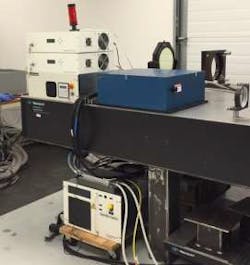Sparkle Optics successfully delivers illuminator laser to AFRL
Sparkle Optics (Menlo Park, CA) received a Phase III Small Business Innovation Research (SBIR) award from the High Energy Laboratory Joint Technology Office (HEL-JTO) in 2012 to develop, optimize, and test illuminator lasers based on Sparkle Optics Rotary Disk Laser (RDL) technology. The contract was managed by the Air Force Research Laboratory (AFRL). The illuminator laser is intended for adaptive optics system testing in Directed Energy (DE) applications. Under this effort, Sparkle Optics designed and developed RDL illuminator lasers with capabilities for both 250 W and 1 kW average output power.
RELATED ARTICLE: Laser ablation and directed energy meet in New Mexico
The 250 W RDL was installed and is now operational at the U.S. Army High Energy Laser Systems Test Facility (HELSTF) on White Sands Missile Range, NM. The 1 kW design was built and computer-controlled laser operation was demonstrated at an intermediate power level to HEL-JTO in a technical interchange meeting in 2015. Sparkle Optics believes that RDL technology can ultimately be scaled to yield much greater than 100 kW of output power at good beam quality (nearly diffraction limited).
Illuminator lasers play a vital role in laser-based missile defense systems, and the JTO SBIR Phase III contract with Sparkle Optics has made it possible for the defense agencies to procure these lasers from a small business. Sparkle Optics has matured an innovative laser technology for use in defense applications and at the same time created high-technology jobs in the private sector.
This is a success story benefitting HEL-JTO, defense projects, the SBIR process, and the small business.
Sparkle Optics delivered a 1030-nm beacon illuminator laser (BILL) to the HELSTF facility of the Department of the Army in January 2016. The illuminator versus diode pump power measured by HELSTF personnel during the acceptance tests after delivery showed that the laser produced 208 W in 37 ns pulses at 30 kHz repetition rate in a single mode TEM00 beam at 525 W pump diode power after delivery and setup at HELSTF. The laser should reach 250 W with 600 W available diode pump power.
The illuminator laser was transported in a rental van (without any damping capability) from California to New Mexico, a distance of 1250 miles. The last 5 miles of the road was not paved, which induced considerable shock and vibration to the delivery van. The laser was installed on the day after delivery. When the laser was turned on for the first time at low power, it lased immediately without requiring any adjustment or alignment.
Personnel have operated the Sparkle Optics laser numerous times per week and have recorded performance to within 15% of the performance since its delivery. Sparkle Optics standard illuminator lasers have routinely operated between 45 F and 90 F in noncondensing environments.
The laser is capable of surpassing fiber lasers in single mode CW operation for High Energy Laser applications and the rotary disk laser operates at many wavelengths of interest and the beam quality is nearly diffraction-limited. Because of absence of thermal aberration and mode size limitation, the rotary disk lasers are reliable and low cost. The laser is modular so that if any component fails in the field, it can be replaced without requiring the entire laser system to be replaced.
SOURCE: Sparkle Optics; http://sparkleoptics.com/pdf/SBIR-Success-Story.pdf
About the Author

Gail Overton
Senior Editor (2004-2020)
Gail has more than 30 years of engineering, marketing, product management, and editorial experience in the photonics and optical communications industry. Before joining the staff at Laser Focus World in 2004, she held many product management and product marketing roles in the fiber-optics industry, most notably at Hughes (El Segundo, CA), GTE Labs (Waltham, MA), Corning (Corning, NY), Photon Kinetics (Beaverton, OR), and Newport Corporation (Irvine, CA). During her marketing career, Gail published articles in WDM Solutions and Sensors magazine and traveled internationally to conduct product and sales training. Gail received her BS degree in physics, with an emphasis in optics, from San Diego State University in San Diego, CA in May 1986.
